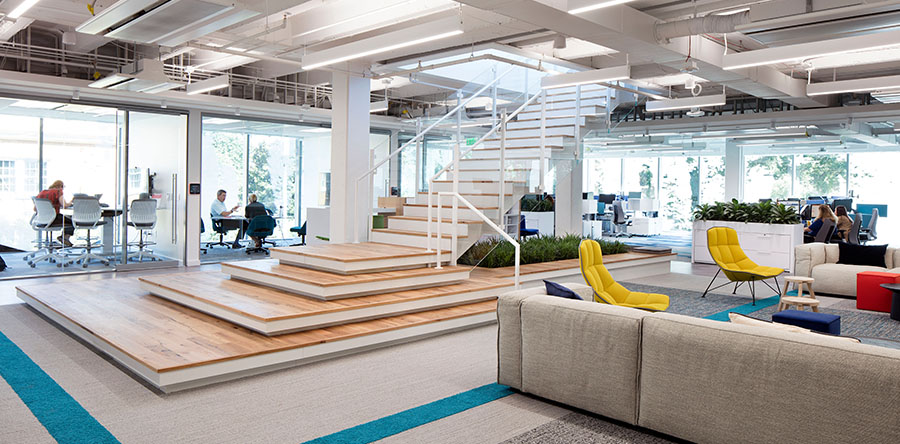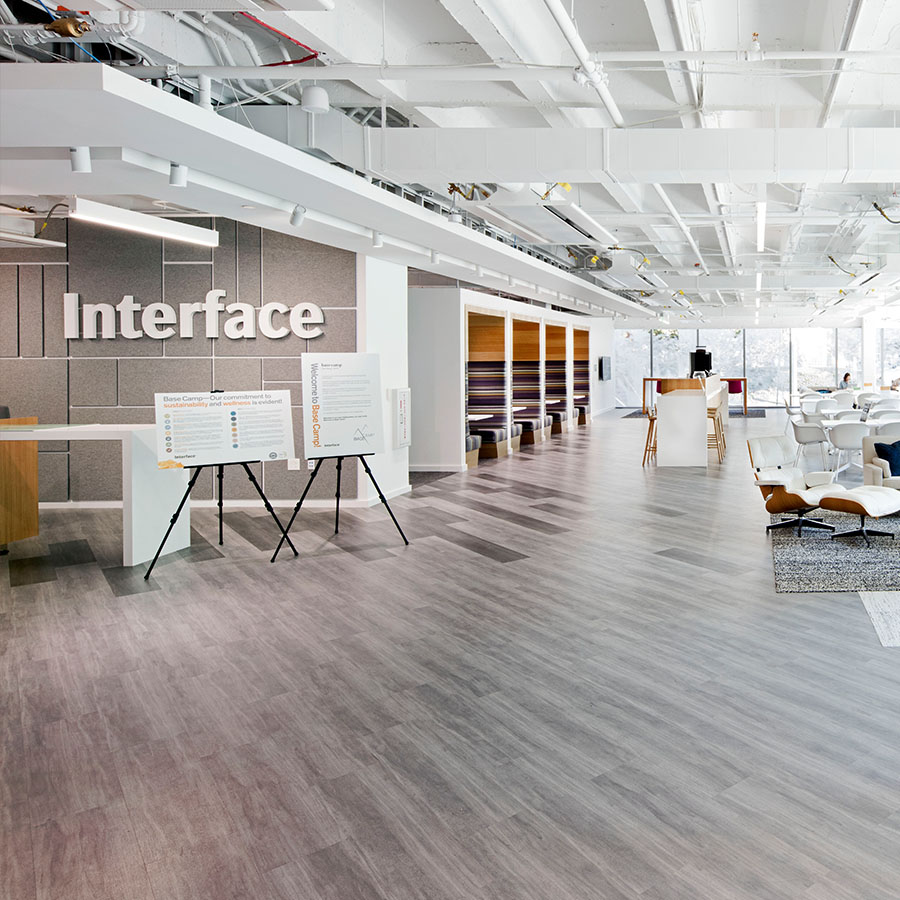
When the New York Times Magazine produced “The Climate Issue” last year, the cover story centered on one company: the Georgia-based flooring manufacturer Interface.
In the past 25 years, Interface has become a beacon to other businesses across the world, providing them with what could be called a template for sustainability.
In 1973, the late Ray C. Anderson founded a first-of-its-kind company, one that specialized in a new realm of
flooring — free lay carpet tile. It was a leader from the beginning. But for more than 20 years, the company gave no regard to sustainable practices.
When stockholders and other interested parties approached him to ask about what Interface was doing in terms of sustainability, Anderson realized it was something he had never even considered — giving back to the environment what the company had taken from it.
But after reading Paul Hawkens’ book “The Ecology of Commerce,” he experienced what he called a “spear-in-the-chest moment,” awakening him to the urgency of sustainability in industry.
He became an ardent advocate, determined to lead Interface in the climb of “Mount Sustainability,” telling everyone in the company that they as a team would become the world’s first environmentally sustainable company.
In the years to come, it would reach that goal and then become the first restorative company, one that spanned four continents. Anderson assembled a task force to get it done.
The man who once had been hesitant to give a speech about sustainability because of his lack of knowledge on the topic became one of its fiercest proponents. He gave speeches not only to encourage sustainability efforts in his own company, but also at plant and sales conferences throughout the industry.
“That was my role — to continue to articulate that vision over and over,” he said in an interview in 2005. “Even when people thought that I’d gone round the bend.”
For a while, people greeted his efforts with blank faces, but then a ripple effect occurred. Interface employee Glenn Thomas wrote a poem, “Tomorrow’s Child,” after he was moved by Anderson’s speeches. It soon became an integral part of the company’s lore.
Minds began to change, and Anderson recalled something he’d heard in his journey: “There’s no such thing as an ex-environmentalist.”
It was the second of two major epiphanies in his life.
“When I saw carpet tiles f foror the first time, I thought, ‘So smart, so right,’” he said in the interview. “When I finally saw sustainability, with Hawkens’ help, it was very much the same feeling: so right, so smart. But orders of magnitude more important.”
He founded an Eco Dream Team and set lofty goals for the team to pursue: zero waste to landfill, zero fossil fuel energy use and zero greenhouse gas emissions. All have been reached, and carbon negativity is now the norm in most sectors of Interface.

David Oakley, who came on board in 1994 to lead Interface’s design team around the concept of mimicking what occurs in nature, is still with the company and is considered a leader of sustainable product design.
Anderson went on to be named Ernst & Young’s Entrepreneur of the Year in 1996, one of many other laurels he would later receive. He was awarded Auburn University’s International Quality of Life Award in 2007, the same year that Time magazine cited him as one of its Heroes of the Environment. In 2010, the year before his death from cancer, he received the American Society of Interior Designers’ Design for Humanity Award.
Following his legacy, the company has accomplished its Mission Zero goals and is pursuing Climate Take Back, resulting in products such as a green tile backing that stores more carbon in its life cycle than it emits.
On June 27, 2021, the piece in the New York Times Magazine ran, with writer Jon Gertner giving readers a look into the company’s inner workings as a leader in carbontech, also known as “carbon-to-value,” which involves the productive use of carbon dioxide. In the article, Gertner wrote:
“Interface requires a detailed accounting of the company’s renewable energy sources, exhaust fumes, supply chains and waste streams. Some of the immense machinery, akin to blocklong newspaper presses, where hot sheets of vinylized carpet filler are rolled out, now runs at lower temperatures to save energy. A short distance away, a recycling center the size of several gymnasiums was crowded with rows of fabric sacks overflowing with nylon filaments, rescued from factory trimmings, ready to be turned into the face cloth for new carpet… jumbo fabric shredders, extruders, hoppers and conveyors rumbled away… (in) the company’s design center, from floor to ceiling, in aisles resembling a supermarket that sold color rather than food, were huge spools of yarn, all recycled, in every conceivable hue.”
The goal is for Interface to be entirely carbon negative by 2040. The company continues to operate under the directions of its founder: “Get up and get going. There’s lots to do.”
—Teri Greene
Interface Highlights
1973: The company constructs its flagship manufacturing facility in LaGrange, Georgia.
1982: Acquires Compact Carpets Ltd. in Belleville, Canada.
1983: Acquires Tufted Carpet Tile Ltd. (Tuca Tile) in Craigavon, Northern Ireland. The company once known as Carpets International-Georgia goes public and changes its name to Interface, Inc.
1984: Acquires Illingworth Morris and Bond Worth, forming Interface UK with the Northern Ireland facility.
1988: Acquires the Dutch manufacturing company Heuga B.V., becoming the world’s largest carpet
tile manufacturer.
1995: Begins reclaiming and recycling carpet tiles through the ReEntry program..
1996: Begins Manufacturing in Chonburi, Thailand. In 2007 this plant became the first LEED certified building in Thailand.
1997: Publishes the first corporate sustainability report. Acquires Carpet Solutions of Australia.
1998: Ray Anderson’s book “Mid-Course Correction: Toward a Sustainable Enterprise: The Interface Model” is published. David Oakley explores biomimicry — considering natural systems to solve
human problems — in carpet tile design. Entropy, a carpet tile inspired by biomimicry, becomes a best-selling product.
2001: GlasBacRE — tile with a recycled content backing and created with layers of recycled content
vinyl — is launched.
2002: Interface donates 72,000 carpet tiles to Auburn University for use as insulated walls for Lucy’s House, a project by Professor Samuel Mockbee and his architecture/design students. Cool Carpet, the first carbon offset program for carpet tiles, is introduced.
2003: TacTiles glue-free installation system is introduced, with a 90% lower environmental footprint than traditional flooring adhesives.
2007: Anderson receives Auburn University’s International Quality of Life Award and is named one of Time magazine’s Heroes of the Environment. Anderson’s second book, “Confessions of a Radical Industrialist: Profits, People, Purpose — Doing Business by Respecting the Earth,” is published.
2011: Manufacturing begins at Interface’s facility in Taicang, China. This earns LEED ID+C: CI Platinum certification for the offices.
2012: Interface invests in Net-Works, a business model that turns discarded fishing nets into 100% recycled content, protecting marine animals and providing supplementary income for community members.
2013: Interface Thailand’s yarn waste becomes raw materials for stuffed animals that community members make and sell as an additional source of income.
2016: Interface’s new mission, Climate Take Back, focuses on creating a climate fit for life.
2018: Interface opens its new global headquarters in Atlanta, known as Base Camp.
2018-19: Interface introduces Carbon Neutral Floors, which offsets carbon emissions of all Interface carpet tile and LVT products globally. In 2019, the company’s nora rubber flooring is included so that all Interface flooring is carbon neutral. Interface celebrates Mission Zero success and releases its 25th Anniversary Sustainability Report.

